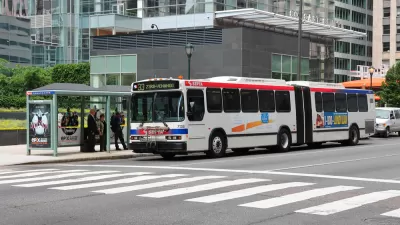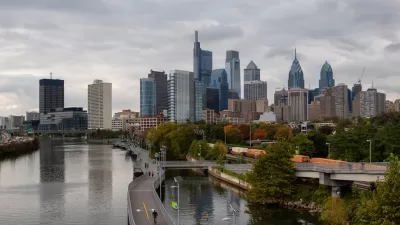The High Line is a famous example of urban revitalization, but a useful commuter path it is not. Can a similar proposal in Philadelphia offer the benefits of beautification and mobility?

Malcom Burnley revisits the idea of a linear park like the one proposed for the Reading Viaduct in Philadelphia as a benefit to the mobility of the city, not just another example of urban beautification similar to the example set by the High Line in New York City.
Burnley tours the proposed route with Michael Garden, boardmember with the Friends of the Rail Park, the driving force behind the proposed project. Before discussing its potential mobility benefits of the park, Brunley provides this summary of the long-term plans for the park:
In Phase 1, the elevated rail line would be repurposed, much like the High Line. In Phase 2, a 1.75-mile stretch of underground tunnels and dug-out space known as the City Branch (or, colloquially in transit circles, as “The Cut”) would be redone into a green corridor with paved throughways that might rival the cool factor of the Schuylkill Banks.
Distinguishing the Viaduct Rail Park proposal from the often-clogged High Line, "Garden envisions both the above-ground and below-ground portions of project as having ample room for bike lanes, running/pedestrian lanes, recreational space and even retail kiosks with coffee (and maybe some of those bougie popsicles)."
Burnley's conclusion after considering Garden's points:
I’d argue that the proposed rail park would not be transformative in the way that, say, stripping parking minimums from the zoning code or creating rapid transit on Roosevelt Boulevard would be. In that sense, maybe it’s a luxury transportation improvement. Nonetheless, it’s one that the city deserves.
The article follows an earlier article by Brunley listing 20 "smart transportation ideas" underway in Philadelphia. At the time, he left the Reading Viaduct off the list. An October study by the Delaware Valley Regional Planning Commission [pdf] concluded the potentially building a bus-only route along the path of the viaduct would be too expensive.
FULL STORY: Reading Viaduct Park Would Make Getting Around Philly Easier

Trump Administration Could Effectively End Housing Voucher Program
Federal officials are eyeing major cuts to the Section 8 program that helps millions of low-income households pay rent.

Planetizen Federal Action Tracker
A weekly monitor of how Trump’s orders and actions are impacting planners and planning in America.

The 120 Year Old Tiny Home Villages That Sheltered San Francisco’s Earthquake Refugees
More than a century ago, San Francisco mobilized to house thousands of residents displaced by the 1906 earthquake. Could their strategy offer a model for the present?

HSR Reaches Key Settlement in Northern California City
The state’s high-speed rail authority reached an agreement with Millbrae, a key city on the train’s proposed route to San Francisco.

Washington State Legislature Passes Parking Reform Bill
A bill that would limit parking requirements for new developments is headed to the governor’s desk.

Missouri Law Would Ban Protections for Housing Voucher Users
A state law seeks to overturn source-of-income discrimination bans passed by several Missouri cities.
Urban Design for Planners 1: Software Tools
This six-course series explores essential urban design concepts using open source software and equips planners with the tools they need to participate fully in the urban design process.
Planning for Universal Design
Learn the tools for implementing Universal Design in planning regulations.
Ada County Highway District
Clanton & Associates, Inc.
Jessamine County Fiscal Court
Institute for Housing and Urban Development Studies (IHS)
City of Grandview
Harvard GSD Executive Education
Toledo-Lucas County Plan Commissions
Salt Lake City
NYU Wagner Graduate School of Public Service





























